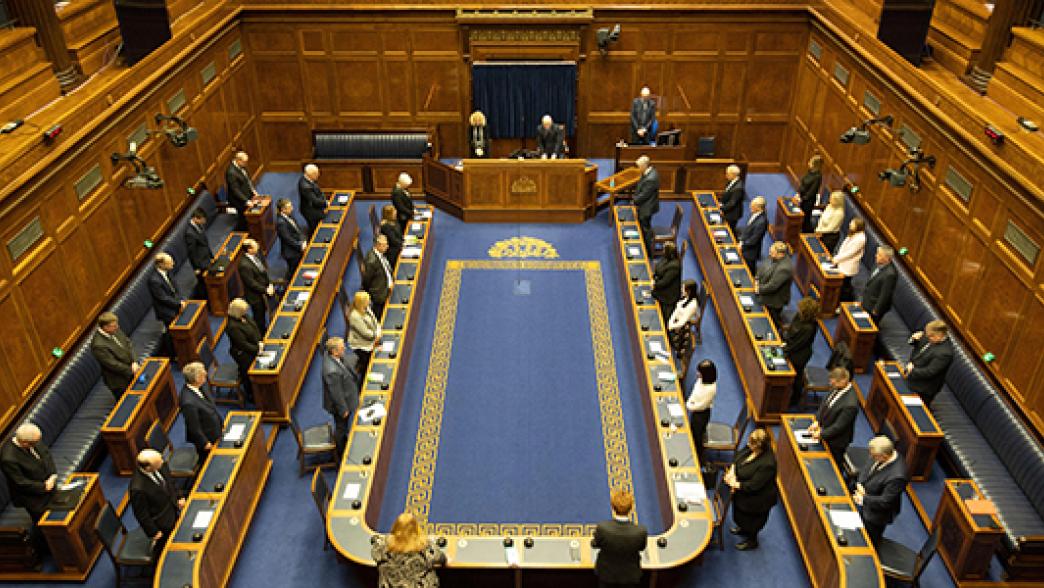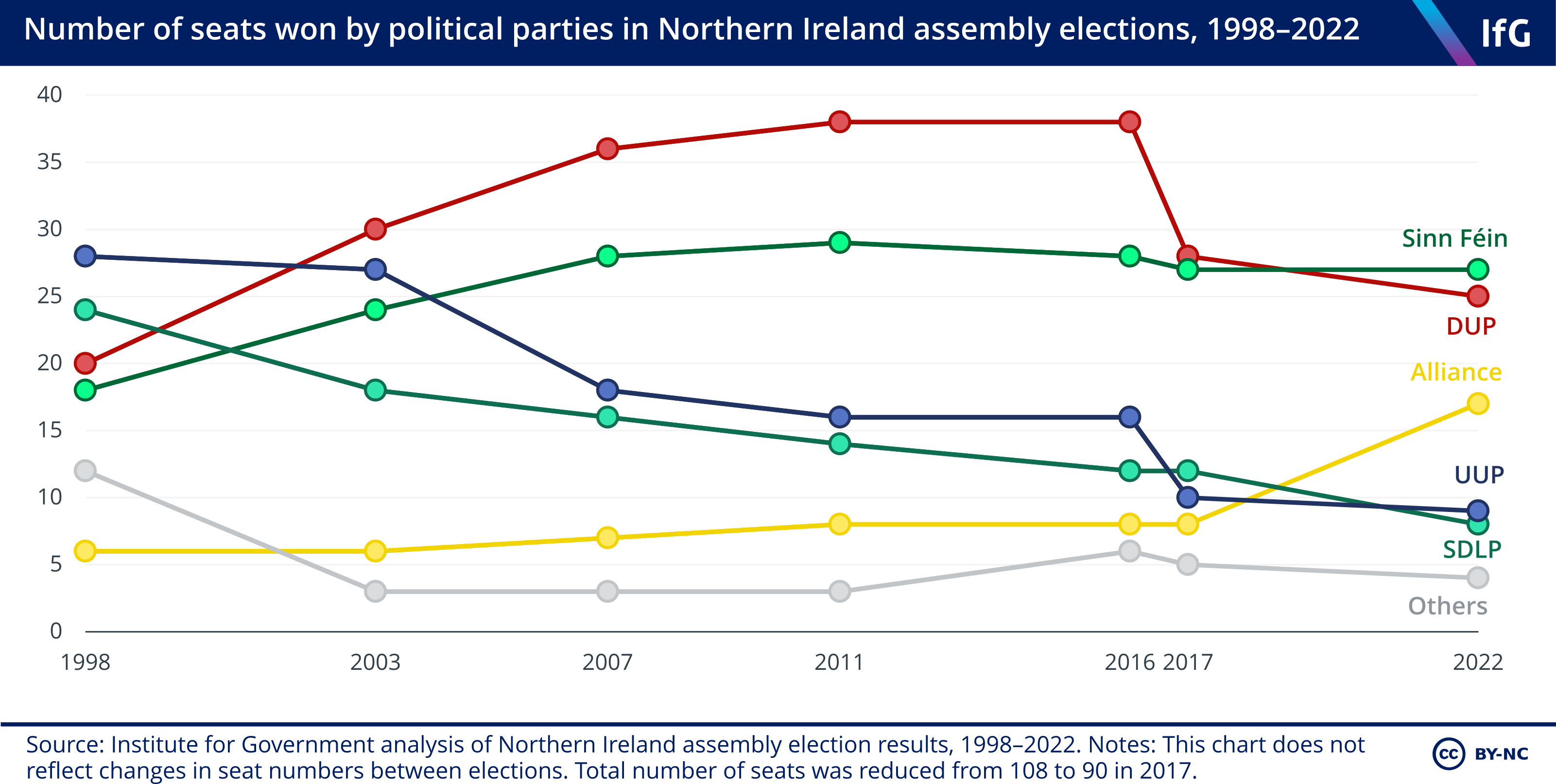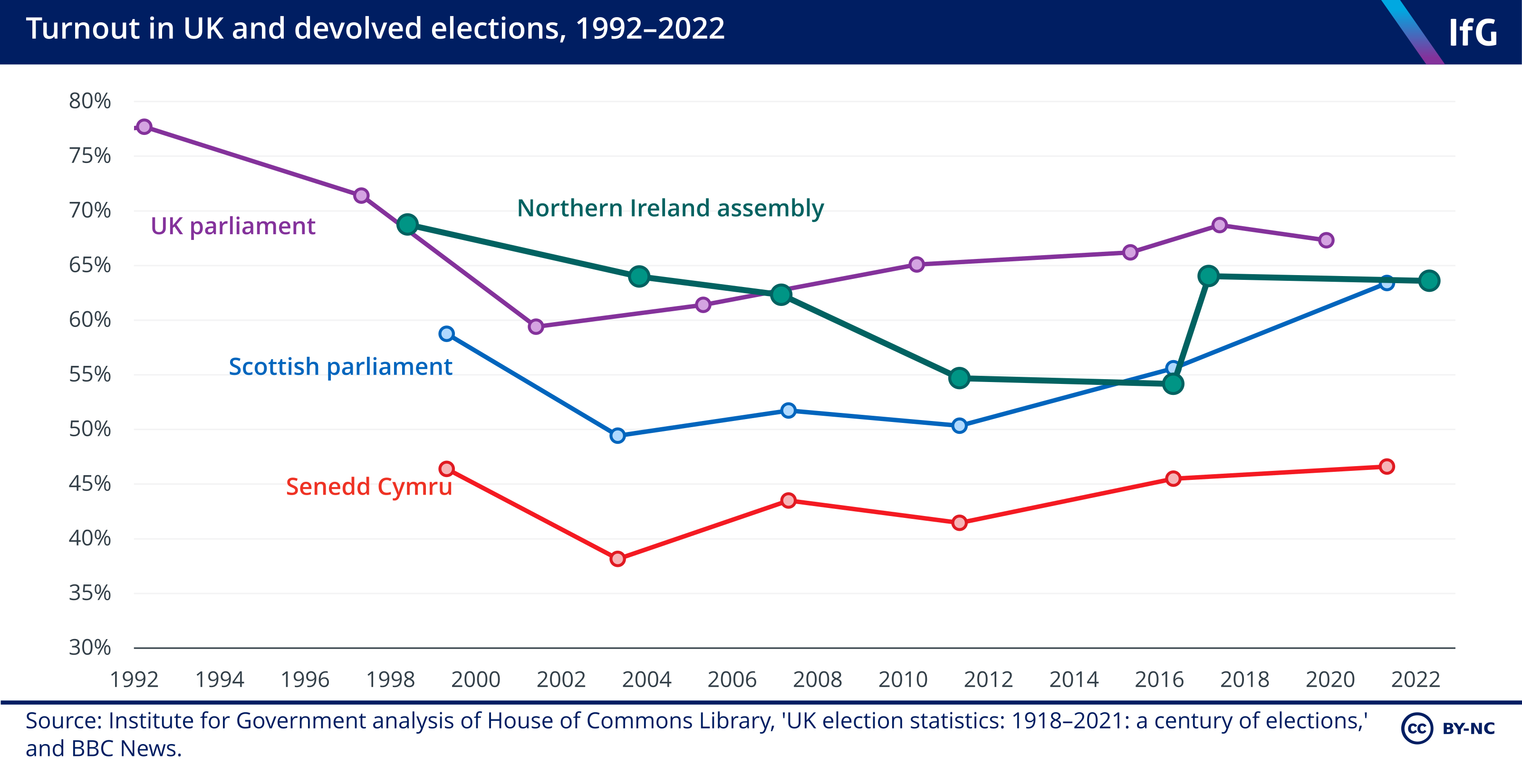Northern Ireland assembly
The Northern Ireland assembly, often referred to as Stormont, is the devolved legislature of Northern Ireland.

The Northern Ireland assembly, often referred to as Stormont, is the devolved legislature of Northern Ireland. It is a unicameral legislature with 90 members elected by the proportional ‘single transferable vote’ system. The assembly was created in 1998 following the Belfast (Good Friday) Agreement. It was designed to facilitate power-sharing between unionists – who support Northern Ireland’s continued place in the UK – and nationalists – who favour a united Ireland – by requiring political parties from the two communities to form a coalition. 22 Northern Ireland Assembly, ‘History of the Assembly’, Northern Ireland Assembly, no date given, retrieved 15 March 2022, archive.niassembly.gov.uk/io/summary/new_summary.htm
Regular elections to the Northern Ireland assembly happen every five years. The most recent election, the assembly’s seventh, took place on Thursday 5 May 2022, with Sinn Féin winning the most seats for the first time. Between May 2022 and January 2024 the Assembly convened on seven occasions in an attempt to nominate a Speaker and Deputy Speaker – a prerequisite for Assembly business to be carried out – but on each occasion failed to do so following opposition from the Democratic Unionist Party (DUP) linked to concerns about the Windsor Framework. In January 2024, having reached a new deal with the UK government, the DUP announced they would seek a return to power-sharing arrangements; in response the Northern Ireland Secretary said all the conditions were in place for the Assembly to return.
What powers does the Northern Ireland assembly have?
The assembly’s legislative powers are set out in the Northern Ireland Act 1998 and divided into three categories: ‘reserved’, ‘excepted’ and ‘transferred’ matters. 23 Torrance D, ‘Devolution in Northern Ireland, 1998-2020’, House of Commons Library, Briefing Paper, CBP 8439, 4 February 2020, researchbriefings.files.parliament.uk/documents/CBP-8439/CBP-8439.pdf
Transferred matters are those that have been fully devolved to the assembly, giving it power to legislate in several areas including health, education, welfare, justice and the environment, among others. Unlike the Scottish and Welsh parliaments, it also has powers over social security, although benefits are directly funded by the UK government on the condition that entitlements remain the same in Northern Ireland as in the rest of the UK.
Reserved matters are those held by the UK parliament, but which can be devolved if the assembly requests this and the UK government agrees. In 2010, powers over policing and justice were devolved, following the Hillsborough Agreement. 24 Northern Ireland Assembly, ‘The power to make laws’, Northern Ireland Assembly, no date given, retrieved 31 March 2022, education.niassembly.gov.uk/post-16/work-assembly/making-legislation/power-make-laws
Excepted matters are exclusively the responsibility of the UK parliament, and include powers over national security, international relations, immigration and asylum policy and the constitution. 25 Torrance D, ‘Devolution in Northern Ireland, 1998-2020’, House of Commons Library, Briefing Paper, CBP 8439, 4 February 2020, researchbriefings.files.parliament.uk/documents/CBP-8439/CBP-8439.pdf
How is the Northern Ireland government funded?
The Northern Ireland executive receives funding through a block grant from the UK central government. The Treasury uses the Barnett formula to determine changes to the block grant that the Northern Ireland executive receives each year to fund devolved services. In 2021, the Treasury announced that the executive would receive an average of £15 billion per year for the next three years. 26 HM Treasury, ‘Latest figures detail UK Government’s record funding of £15 billion a year for the Northern Ireland Executive’, press release, HM Treasury, 15 December 2021, retrieved 25 March 2022, www.gov.uk/government/news/latest-figures-detail-uk-governments-record-funding-of-15-billion-a-year-for-the-northern-ireland-executive
The executive also receives some revenue through taxes that it controls, although this is minimal. This funding comes from the regional rate, a domestic and non-domestic property tax. 27 Scholes M, ‘What are rates and why do we pay them?’, Northern Ireland Assembly Research and Information Service, 22 March 2018, retrieved 25 March 2022, www.assemblyresearchmatters.org/2018/03/22/what-are-rates-and-why-do-we-pay-them/ In 2015, legislation was also passed to devolve control of corporation tax but the power to cut corporation tax rates in Northern Ireland has not yet been used.
As part of a review into increasing fiscal powers of the Northern Ireland assembly, the Independent Fiscal Commission Northern Ireland has called for income tax to be devolved to Northern Ireland and will publish a report with their conclusions in late 2022. 28 Campbell J, ‘Income tax: Call to devolve powers to Northern Ireland’, BBC, 23 March 2022, retrieved 25 March 2022, www.bbc.co.uk/news/uk-northern-ireland-60833904
How do Northern Ireland assembly elections work?
Elections to the Northern Ireland assembly use the single transferable vote (STV) electoral system, a form of proportional representation.
There are 18 constituencies for elections to the Northern Ireland assembly and these are the same as for elections to the UK parliament. Each constituency elects five MLAs, giving a total of 90.
How is government formed after the Northern Ireland assembly elections?
Following an election, the assembly meets within eight days. On the first day, MLAs are required to designate themselves as ‘unionist’, ‘nationalist’ or ‘other’. The largest party is entitled to nominate a first minister and the largest party from the second-largest designation a deputy first minister (unless the largest party is not from the largest designation. For more detail, see our explainer on government formation in Northern Ireland). The two positions have equal powers and one cannot hold office without the other being in post.
The parties then have up to 24 weeks (an initial six-week period which can be extended three times) to nominate a first minister and deputy first minister.
If a first and deputy first minister are appointed within the 24-week period, other ministerial positions are then allocated using a special formula (d’Hondt) to determine the number of positions each party is entitled to, and the order in which they can make their nominations. Parties can choose whether to take up these positions or to join the official opposition, as the Ulster Unionist Party (UUP) and Social Democratic and Labour Party (SDLP) did in 2016, in which case their entitlements are reallocated. The exception is the justice minister who is appointed by a cross-community consent vote.
If no first minister or deputy first minister are appointed within those 24 weeks, all ministers cease to hold office and the secretary of state for Northern Ireland is obliged to call another election.
Which parties are represented in the Northern Ireland assembly?
Following the May 2022 election, there are seven political parties represented in the assembly, as well as two independents. Sinn Féin, a nationalist party, won the most seats in the assembly for the first time at the 2022 election. The party won 27 seats, the same number it won in 2017, while the Democratic Unionist Party (DUP) saw its seats fall from 28 to 25.
Alliance saw a surge in seat numbers, winning 17 seats, an increase of nine from the eight seats the party won in 2017. The Ulster Unionist Party (UUP) and the Social Democratic and Labour Party (SDLP) won nine and eight seats respectively, both having lost seats compared to 2017.
Two independent unionist candidates won seats, Traditional Unionist Voice (TUV) and People Before Profit (PBP) both retained their one seat each. Meanwhile, the Greens lost both their seats and are no longer represented in the assembly.
Which parties are represented in the Northern Ireland executive?
As the largest party, Sinn Féin is entitled to the first minister position, and the DUP – as the largest party in the unionist designation – is entitled to the deputy first minister position. Other ministerial positions are not allocated until the first minister and deputy first minister positions have been appointed, and so we do not yet know which parties will choose to go into government and what positions they will take up.
During the executive formation period, caretaker ministers from before the election will remain in post, with the exception of the infrastructure minister, Nichola Mallon, who lost her seat in the 2022 assembly election. If the SDLP does not nominate a replacement, Sinn Féin, as the next party entitled to nominate under d’Hondt formula, may have the opportunity to do so.

Turnout at Northern Ireland assembly elections decreased between 1998 and 2016, before increasing sharply from 54% at the 2016 election to 65% at the 2017 election. In 2022, these levels of participation were maintained with turnout dropping only slightly to 64%.

What has happened at previous Northern Ireland assembly elections?
A total of seven elections to the Northern Ireland assembly have taken place (1998, 2003, 2007, 2011, 2016, 2017, 2022). Until 2017, 108 MLAs were elected at assembly elections which is reflected in the drop in seats of some major parties in 2017, when the reduced number of 90 MLAs were elected for the first time.
Following the first assembly elections in 1998, the UUP was the largest party, however its number of seats has decreased over time. Similarly, the SDLP won the second-highest number of seats in 1998, but its support has also fallen. In contrast, the DUP and Sinn Féin have generally increased their number of seats over time and have been the two largest parties ever since the 2007 election. Alliance was consistently the fifth largest party in terms of seats won from 1998 to 2017.
- Topic
- Devolution
- Keywords
- Local elections
- Publisher
- Institute for Government